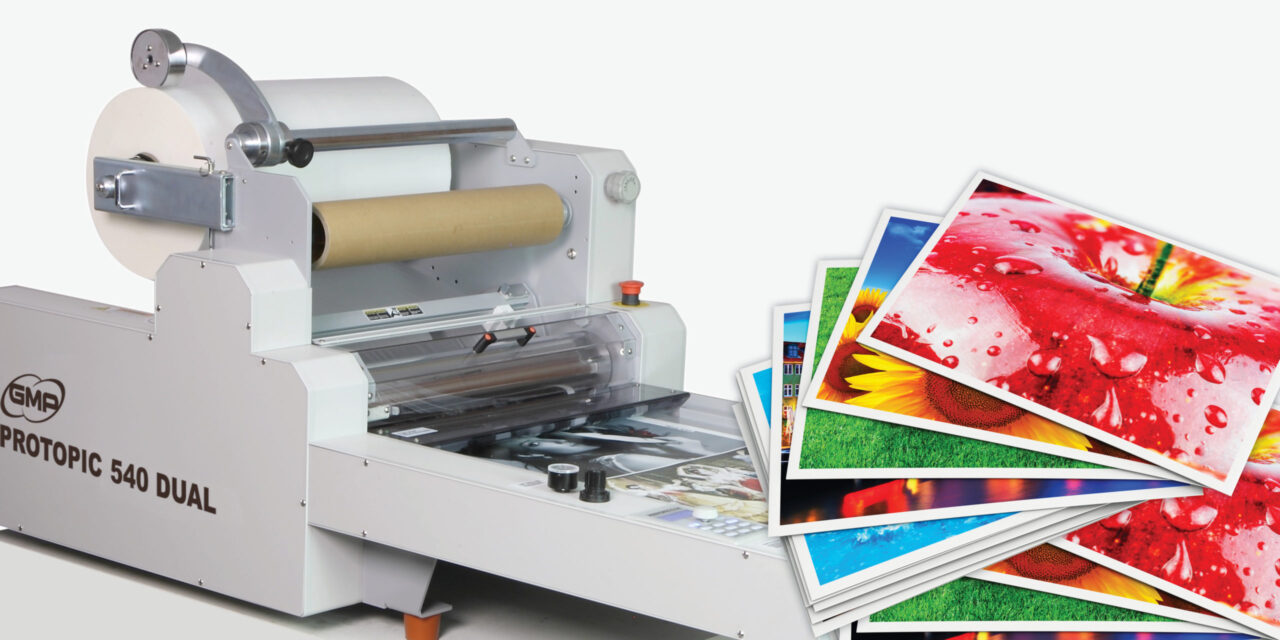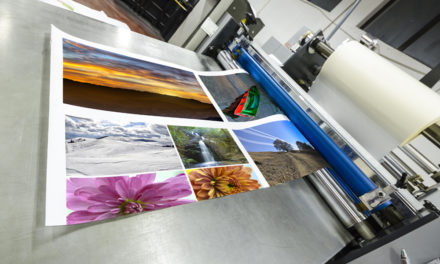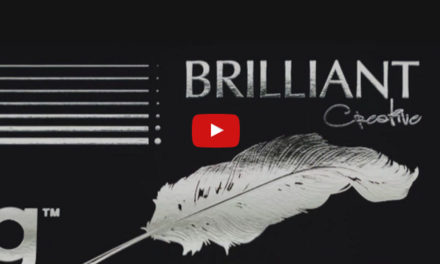THE GREAT PHOTO SHIFT
In our recent blog post, Silver Halide Replacement: The Future of Photofinishing, we covered current issues in the silver halide market and how many photofinishers have begun turning to other photo printing methods to fill in gaps in production. If you are one of the many printers looking to incorporate digital photo printing into your operation, you might be unsure where to start. New materials, suppliers, equipment, service needs – the number of moving parts can feel overwhelming. This article aims to help photofinishers look at the big picture and understand the most crucial components they’ll need to start digitally printing photographs using silver halide replacement, or SHR™.
KEY EQUIPMENT FOR SHR
Unlike the silver halide photo printing process, which involves highly specialized paper, chemicals, and equipment, SHR utilizes the same materials and technology as a range of other products in general commercial print. As a result, photofinishers who adopt digital printing will see more flexibility regarding which companies they partner with, but they will also need to understand the pros and cons of different options to ensure they find the best solution for their specific operation. SHR requires three major pieces of equipment: a digital press to print the photos, an embossing laminator to provide them with protection and a silver halide luster, and a cutter to separate images printed on the same sheet.
Each step will require unique equipment to print photographs at production volumes. Although purchasing and integrating a new set of equipment comes at a cost, the supply chain freedom and affordability of SHR will result in a significant return on investment for the average photofinisher. Additionally, digital printing technology opens the door to more than just photos; the same equipment that enables photofinishers to fulfill orders from a school picture day can be used to create bookmarks, calendars, and more all in the same workspace.
PRINTING
When it comes to printing, photofinishers can take their pick from a wide variety of digital presses that can produce high-resolution prints faster than ever before. There are a few key points that should be considered before deciding on a press; the importance of each will vary depending on the specific operation’s needs.
- Quality – While the HP Indigo line has long been considered a go-to for digital printing due to its excellent color tonality, all major digital technologies have developed to a point where they can accurately reflect the quality of traditional silver halide when coupled with lamination. Because photographs can vary wildly in focus and subject, from portraits and landscapes to experimental artistic pieces, photofinishers will want to find the press that best services their particular customer demographic.
- Capacity – After verifying that any given press satisfies your operation’s quality needs, the second most important consideration is the press’s throughput capabilities. In a properly planned SHR workflow, one digital press should be able to consolidate the workload of multiple silver halide presses and fulfill the needs of a printshop’s average daily volume. Most brands publish specification sheets for individual presses on their site to help potential customers know exactly how much they can expect their equipment to handle. Among Nobelus customers who use SHR, Canon presses have proven to be reliable and capable of producing thousands of photos a day. At especially high volumes, photofinishers may want to look at roll-to-roll options.
- Compatibility – Most digital platforms can run sheets as large as 13″ x 19″, which is suitable for a variety of photo sizes. Some inkjet presses are able to run sheets as large as 23″ x 29″, but these units are pricier, typically costing about twice as much. Knowing that a variety of photo sizes can be digitally printed on the same sheet of paper, consider which format will best accommodate the most frequently ordered sizes. In terms of lamination compatibility, the adhesive layer on SHR Laminate has demonstrated the ability to reach satisfactory bond levels with common digital ink outputs, such as aqueous and UV inkjet, dry toners, and electrostatic inks.
PROTECTION
Photofinishers should be sure to find a laminator that produces high-quality results, meets their daily volume in peak season, and has embossing capabilities to properly replicate the luster of traditional silver halide photos. However, the best laminator for any given operation is also highly dependent on what type of paper is being used.
Photo Paper – With the rise of digital photo printing, some companies have begun producing specialized photo paper that has the traditional emulsion backing of silver halide paper while being highly compatible with digital presses. While this option will incur higher expenses when sourcing photo paper, it also enables photofinishers to purchase a more affordable single-sided laminator without reducing efficiency. In this case, photos can be passed through the laminator a single time to receive a protective top layer of SHR Laminate, which is embossed using a roller attachment, while the built-in backing protects the photo from dirt, fingerprints, and moisture.
Standard Paper – This option is more affordable and provides more flexibility in terms of weight and sizing, but it will require lamination on both sides to protect the finished product and maintain proper tension so the photo lies flat. Photofinishers who go this route will have two options: run photos through a single-sided laminator twice by laminating one side at a time or purchase a double-sided laminator that laminates both the front and back in a single pass through the machine. If you print large volumes of photos and will see a good return on investment from a high-efficiency machine, a pricier double-sided laminator is likely the best option. However, operations that have the time and volume to perform two lamination passes may prefer the lower cost of a single-sided laminator. For this workflow, we recommend using a matte laminate on the back to replicate the appeal of an emulsion backing.
GMP produces many laminators that are especially conducive to SHR, such as the PODMaster and Protopic lines, with a variety of features and optional enhancements. High-volume printshops can benefit greatly from the roll-fed GMP LamiMaster, which is specially designed for production SHR. All of these units make use of an embossing roller to give digitally printed photos the memorable texture customers have come to expect from their photographs. If you want to learn more about laminating equipment, take a look at the equipment page on the Nobelus site to explore different brands and options.
PROCESSING
Photofinishers have two major needs that should be met by any post-lamination processing equipment: cutting and sorting. Smaller printshops may be able to meet demand for both steps through manual processing, negating the need for pricier investments. To perform cutting by hand, operators will need near-line XY manual cutting systems that allow them to accurately and quickly separate different photo sizes printed on the same sheet of paper. Sorting photos can be done without any equipment at all so long as the output volume is manageable. However, most printshops with a significant number of daily orders will need the reliability and efficiency of automatic cutting and sorting equipment.
Cutting – Like most other technologies in the printing industry, cutters have become incredibly advanced and are engineered with more features and functionality than ever before. Modern cutting equipment can perform dozens of vertical and horizontal cuts on a single sheet, enabling printers to process several designs of varying sizes at once with full accuracy. Some units can even be programmed to read a digitally printed barcode that activates pre-set configurations, perfect for processing standardized photo packages for parents who order a set number of portraits, wallet photos, and more. While the speed at which any given cutter processes a print job will vary based on the complexity of the cuts, most brands will be able to provide photofinishers with detailed information about how many sheets can be cut on an average day. Make sure the cutter you purchase is compatible in terms of both volume and complexity.
Sorting – Photofinishers who have large-volume orders know that their reputation depends in large part on fulfilling orders accurately; no parent likes finding another person’s child in the envelope containing their daughter’s school pictures. They will also need to find an inserting solution to make sure photos get to the right envelope or package in a timely fashion. For these printshops, one potential solution comes from the world of direct mail. This industry makes use of specially designed machines that are capable of sorting huge volumes of prints and inserting them cleanly into their designated package. Photofinishers interested in this type of equipment should verify that the financial cost will be offset by increased capacity and lower labor requirements.
ASK US FOR MORE INFORMATION
Now that you know the basics of what equipment you’ll need for SHR, it’s time to start comparing your options and find the workflow system that fits your operation best. With our network of partners and industry allies in printing, laminating, and processing, Nobelus is ready to get you connected with reputable companies that offer stellar solutions. Our customer representatives and strategic solutions experts can provide guidance on where to start your search and answer any questions that come up.





